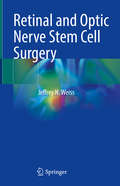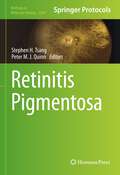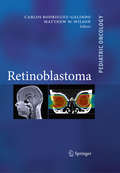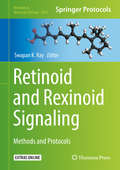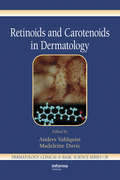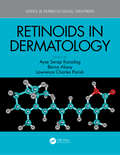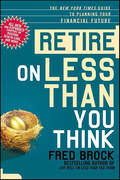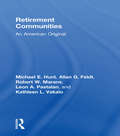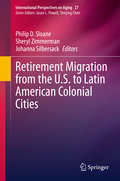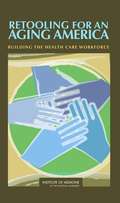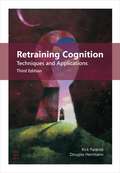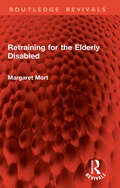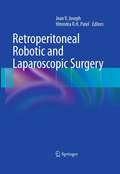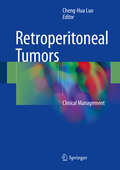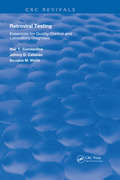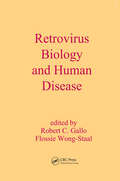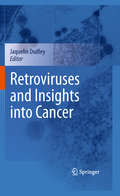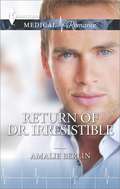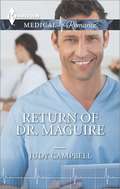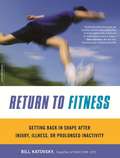- Table View
- List View
Retinal and Optic Nerve Stem Cell Surgery
by Jeffrey N. WeissThis is a concise how-to of successfully treating previously deemed "untreatable" retinal and optic nerve conditions with stem cell therapies. Based on the results of 11 years of experience treating approximately 600 patients, this text will serve as a template for others to develop similar stem cell based treatments in their specialty. Author, Jeffrey N. Weiss, MD is specifically poised to offer dependable insight on stem cell surgery for both the retina and the optic nerve, having performed the first retinal stem cell surgery in 2010, with Institutional Review Board (IRB) approved studies that are registered with the National Institute of Health (NIH), and listed on ClinicalTrials.gov. Featuring all original work from Dr. Jeffrey Weiss's specialization in stem cell ophthalmology, this book is primarily written for ophthalmologists, but structured so that specialists across disciplines can take the model presented and create their own studies and clinical trials using stem cell therapies.
Retinitis Pigmentosa (Methods in Molecular Biology #2560)
by Stephen H. Tsang Peter M. J. QuinnThis volume details the history of Retinitis Pigmentosa and current treatment options. Chapters guide readers through CRISPR, gene therapy, stem cell therapy, next-generation sequencing methods, gene editing, and translational applications of other therapies to the treatment of Retinitis Pigmentosa. Written in the successful Methods in Molecular Biology series format, chapters include introductions to their respective topics, lists of the necessary materials and reagents, step-by-step, readily reproducible protocols, and notes on troubleshooting and avoiding known pitfalls. Authoritative and cutting-edge, Retinitis Pigmentosa aims to be a useful practical guide to researches to help further their study in this field.
Retinoblastoma
by Matthew W. WilsonTreatment of retinoblastoma has evolved at a significant speed over the last two decades; ocular salvage approaches are now at the core of modern treatments, and assessment of visual and functional outcomes has become a priority. New discoveries in retinoblastoma biology are leading the way to the development of targeted therapies that could revolutionize our current approaches to the treatment. In this book, experts address all the important aspects of research and therapy - from biology to epidemiology to treatment. Retinoblastoma will provide a single source for the diagnosis and care of children with this malignancy.
Retinoid and Rexinoid Signaling: Methods and Protocols (Methods in Molecular Biology #2019)
by Swapan K. RayThis volume explores the latest synthetic procedures for producing receptor-specific retinoids and rexinoids, molecular biology methods, and new technologies to demonstrate the therapeutic activities of molecules. The chapters in this book cover topics such as lentiviral delivery of shRNA constructs into acute promyelocytic leukemia cells for ATRA induced differentiation and autophagy; methods to analyze RAR signaling in colorectal cancer cells; differentiation of primary myoblasts by using RXR agonist; methodology for analyzing effects of retinoid treatment on nervous system development and larval swimming behavior; and protocols for assessment of autophagic flux in ATRA treated 2D and 3D breast cancer cultures. Written in the highly successful Methods in Molecular Biology series format, chapters include introductions to their respective topics, lists of the necessary materials and reagents, step-by-step, readily reproducible laboratory protocols, and tips on troubleshooting and avoiding known pitfalls.Cutting-edge and comprehensive, Retinoid and Rexinoid Signaling: Methods and Protocols is a valuable resources for graduate students, postdoctoral fellows, and principal investigators who are interested in further exploring the signaling mechanisms of these molecules in their specific preclinical models.
Retinoids
by Gabriel H. Travis Hui SunNew and exciting biological functions are still being discovered for vitamin A derivatives, including the vast number of physiological activities of retinoids. In Retinoids: Methods and Protocols, expert researchers in the field present the most recent technical tools with diverse techniques for both in vitro and in vivo studies. Combining biochemical, biophysical, and cell biological techniques, the book addresses topics such as the detection and quantitation of retinoids using HPLC, mass spectrometry, and fluorescence, fluorescence anisotropy of retinol binding protein, cell culture models for studying retinoid transport and the role of retinol in embryonic stem cell culture, as well as many other detailed procedures. Written in the highly successful Methods in Molecular BiologyTM series format, chapters include introductions to their respective subjects, lists of the necessary materials and reagents, step-by-step, readily reproducible laboratory protocols, and notes highlighting tips on troubleshooting and avoiding known pitfalls. Authoritative and cutting-edge, Retinoids: Methods and Protocols seeks to aid beginning and experienced researchers from widely varied fields in the search to uncover even more vital aspects of vitamin A's impact on the human body.
Retinoids and Carotenoids in Dermatology (Basic and Clinical Dermatology)
by Anders Vahlquist Madeleine DuvicThis up-to-date reference describes how retinoids and carotenoids function in the skin and how they can be utilized to prevent and treat a wide variety of skin diseases, as well as advance biomedical research in relation to cancer treatment and immunology. Providing an in-depth update on the pharmacology, pharmacodynamics, and new applications of
Retinoids in Dermatology (Series in Dermatological Treatment)
by Lawrence Charles Parish Ayse Serap Karadag Berna AksoyThis up-to-date reference on the use of retinoids in dermatology presents how retinoids function in the skin, how they can best be used to treat and prevent various skin diseases, and how they can be monitored effectively. The text will provide an in-depth update on the pharmacology, clinical use, side effects, and follow-up of retinoid therapy in dermatology. This source also addresses topics related to retinoid use in special circumstances, such as vulnerable populations, concomitant surgery, and aesthetic procedures.
Retinopathy of Prematurity
by B. Andrés Kychenthal S. Paola DortaThis clinically oriented book is devoted to the diagnosis and treatment of retinopathy of prematurity (ROP), a leading cause of childhood blindness. World-renowned experts in the field discuss epidemiologic and pathogenic aspects of the disease. The staging and classification of ROP are explained in detail, and guidance is provided on appropriate anesthesia. The state of the art in imaging of ROP is described and illustrated, with coverage of the advances in ophthalmic imaging technology and telemedicine that have revolutionized pediatric retinal examinations and contributed significantly in elucidating the pathophysiology of ROP and improving diagnosis and treatment. Treatment indications and therapeutic alternatives, including the use of antiproliferative drugs, are addressed in separate chapters, supplying the reader with the most up-to-date knowledge in the field.
Retire on Less Than You Think: The New York Times Guide to Planning Your Financial Future
by Fred BrockThe bestselling, hands-on retirement guide, thoroughly updated and expanded for in-depth advice on housing assets, health-care options, and more.With Retire on Less Than You Think: The New York Times Guide to Planning Your Financial Future, Fred Brock challenged the conventional wisdom on the real costs of retirement—and it struck a chord with Americans. Now, the finance expert has updated his indispensable advice on finding asset streams, working during retirement, maximizing your health insurance, and choosing a community and housing to show how to• manage the quicksand of the housing market (your best asset)• pay for the spiraling costs of prescription drugs• discover new cost-cutting savings• plan for shifts over time in your financial goalsBoasting expanded resource lists and worksheets, Retire on Less Than You Think is the best guide available for making your retirement dreams a reality.“Valuable.” —Newsweek“Need some encouragement to think boldly? Get yourself a copy of Retire on Less Than You Think.” —Dallas Morning News“Plenty of helpful and useful material . . . For workers intrigued by the idea of retiring for less, Brock's book is well worth reading.” —Boston Globe
Retirement Communities: An American Original
by Leon A Pastalan Michael E Hunt Allan G Feldt Robert W Marans Kathleen L VakaloThis insightful book focuses on state-of-the-art retirement communities in the United States today. Experts from the fields of urban planning, architecture, and aging present in-depth profiles of a variety of retirement communities. The changing function and character of retirement communities--resulting from changes in supply and demand, alternate lifestyles, and other environmental needs of an ever-increasing aging population--are explored. The timely discussions in this useful resource offer insights into the relative strengths and weaknesses of various types of retirement communities with respect to the varying needs, abilities, and desires of older people.
Retirement Migration from the U.S. to Latin American Colonial Cities (International Perspectives on Aging #27)
by Sheryl Zimmerman Philip D. Sloane Johanna SilbersackThis book provides a comprehensive overview of a growing phenomenon in migration: retired Americans moving to Latin America. Through in-depth profiles of two of the most popular destinations – Cuenca, Ecuador and San Miguel de Allende, Mexico, the book provides a unique commentary on the social forces shaping this new diaspora and its impact on the settings to which retirees relocate. Sections of the book address the lives and activities of retirees themselves; their impact on real estate, business development, and gentrification within historic cities; the availability and access to medical and long-term care services; and the role of governmental policies in attracting immigrant retirees and shaping their societal impact. Concluding sections provide guidance for potential retirees and for cities and countries interested in attracting these new immigrants while minimizing adverse impact on local culture and quality of life. Carefully researched and extensively illustrated with photographs, maps, figures, and tables, the book serves as an important new resource for scientists and policy makers, as well as for baby boomers who have retired abroad or are considering doing so.
Retooling For An Aging America: Building The Health Care Workforce
by Institute of Medicine of the National AcademiesAs the first of the nation's 78 million baby boomers begin reaching age 65 in 2011, they will face a health care workforce that is too small and woefully unprepared to meet their specific health needs. Retooling for an Aging America calls for bold initiatives starting immediately to train all health care providers in the basics of geriatric care and to prepare family members and other informal caregivers, who currently receive little or no training in how to tend to their aging loved ones. The book also recommends that Medicare, Medicaid, and other health plans pay higher rates to boost recruitment and retention of geriatric specialists and care aides. Educators and health professional groups can use Retooling for an Aging America to institute or increase formal education and training in geriatrics. Consumer groups can use the book to advocate for improving the care for older adults. Health care professional and occupational groups can use it to improve the quality of health care jobs.
Retraining Cognition: Techniques and Applications (Third Edition)
by Rick Parenté Douglas J. HerrmannTextbook on cognitive rehabilitation therapy, for psychology and rehabilitation students. Discusses therapeutic methods and their theoretical foundations in cognitive psychology, neuropsychology, and speech.
Retraining for the Elderly Disabled (Routledge Revivals)
by Margaret MortMany elderly patients have long-term physical disability and in order for them to maintain a certain level of independence either in hospital or in the community, great attention must be paid to devising programmes to overcome problems and enhance residual abilities.Originally published in 1985, the programme described in this book had developed over the previous 25 years at the Royal Newcastle Hospital in Australia. It grew in response to the practical needs of patients who, having been treated by conventional means, were left with residual disabilities to a degree that their successful return to the community was jeopardised. The retraining programme described is a problem-solving process, coordinated under one director, combined with close teamwork between staff, the patient and relatives. Throughout, attention is paid to social and psychological factors as well as physical problems, when discussing physical retraining methods involving the repetition of routine movements.
Retrolental Fibroplasia and Autistic Symptomatology: An Investigation into Some Relationships Among Neonatal, Environmental, Developmental and Affective Variables in Blind Prematures
by Joan B. ChaseIn this monograph, based on a study of 263 subjects with RLF (Retrolental Fibroplasia-- an eye condition caused by excessive incubator oxygen), the author examines selected variables which may significantly affect subsequent development.
Retroperitoneal Robotic and Laparoscopic Surgery
by Hitendra R.H. Patel Jean V. JosephRetroperitoneal Robotic and Laparoscopic Surgery provides urologists with an easy way to learn the extraperitoneal alternative when performing laparoscopic or robot assisted procedures. There are significant technical differences between intra-peritoneal and retroperitoneal surgery. There are occasions, particularly with a history of prior intra-abdominal surgeries, when the retroperitoneal route is not only less invasive, but provides an efficient and effective way of performing the operation. Retroperitoneal Robotic and Laparoscopic Surgery is a step-by-step guide of all extraperitoneal laparoscopic and robot assisted procedures. This book will support beginners in making the transition from open extraperitoneal to laparoscopic or robotic extraperitoneal procedures. It is also a valuable reference tool to further assist the intermediate and advanced laparoscopist to expand their skills working in the extraperitoneal space.
Retroperitoneal Tumors: Clinical Management
by Cheng-Hua LuoThis book provides a comprehensive, state-of-the-art review of the diagnosis and management of retroperitoneal tumors. It highlights current surgical techniques for combined resection and reconstruction of various abdominal and pelvic organs and structures, along with adjuvant therapy. The book consists of three parts: Part 1 summarizes basic knowledge on retroperitoneal tumors and provides a detailed introduction to diagnosis and treatment, while Part 2 focuses on the surgical techniques used for retroperitoneal tumors and describes general procedures for operations on retroperitoneal tumors at different sites. Lastly, Part 3 details the etiology, pathology, evaluation, treatment and prognosis of retroperitoneal tumors according to pathological subtypes. This book is designed as a resource and guide for surgical and medical oncologists working with retroperitoneal tumors.
Retroviral Testing: Essentials For Quality Control and Laboratory Diagnosis (Routledge Revivals)
by Niel T. Constantine Johnny D. Callahan Douglas M. WattsFirst published in 1992, Retroviral Testing: Essentials for Quality Control and Laboratory Diagnosis is a concise, well-organized volume that discusses the background of retroviral disease, available testing technologies, test result interpretation, new testing alternatives, and essential quality control/quality assurance measures necessary for achieving accurate test results. It provides fundamental information on the epidemiology and infections caused by HIV and HTLV retroviruses, in addition to covering standards for handling blood samples.Other features include a description of immune responses to retroviral agents and a detailed examination of the principles, interpretation, usage and advantages of numerous screening and confirmatory assays. Methods to evaluate diagnostic assays and statistical methods to assess test performance are covered. The text is supplemented by 57 diagrams and 14 tables, including an extensive list of over 130 diagnostic assays for the retroviruses.Retroviral Testing: Essentials for Quality Control and Laboratory Diagnosis is an absolutely critical reference for all medical laboratories, medical technologists, educators, blood bank and immunology supervisors and personnel, and organizations such as WHO and CDC.
Retrovirale
by Jean De BlonayGinevra, giugno 2021. Mentre una pandemia si scatena in tutto il mondo, Ornella Conti cerca di svelare il mistero della morte di suo marito Michael. Quattro anni prima, era stato contattato da un'organizzazione filantropica per partecipare al loro massiccio progetto di sviluppare un vaccino che potesse curare diverse malattie mortali. La coppia accettò di trasferirsi sull'isola dove sarebbe stato costruito il laboratorio top-secret. Ma le cose andarono a rotoli e, mentre cerca di illuminare il passato alla luce del presente, Ornella diventa il bersaglio di un complotto diabolico... In questo romanzo accattivante, Jean de Blonay evoca in modo sottile e intelligente l'attualità al centro di una trama movimentata in cui virus, cospirazione e romanticismo formano un cocktail esplosivo.
Retrovirus Biology and Human Disease
by Robert C. Gallo Flossie Wong-StaalThis book captures some of the essential developments, both historical and current, relating to the human retroviruses and the diseases they cause. It describes detailed molecular biology and epidemiology of human T-leukemia virus type 1 (HTLV-1).
Retroviruses and Insights into Cancer
by Jaquelin DudleyThis book will contain a series of review articles that focus on retroviral models of human and animal cancers. Each article will be written by an expert in the field of retrovirology. The reviews will summarize current work on a particular retrovirus, with particular emphasis on the relevance of this research to human disease.
Return of Dr. Irresistible
by Amalie BerlinSparks fly with her ex...Emergency medical technician Jolie Bohannon never expected to see childhood sweetheart Dr. Reece Keightly again. Not since he abandoned her all those years ago... Now he's back to close down his family's circus-and it feels as if he's tearing down her life all over again!After everything she's been through Jolie wants nothing more to do with Reece. But after one scorching, passionate tryst it's clear that Jolie will always find Reece completely irresistible! Should she trust him with her heart...?
Return of Dr. Maguire
by Judy CampbellThe prodigal doctor returns...When flying doctor Lachlan Maguire returns to Scotland to claim his inheritance, the dilapidated Highlands surgery left to him by his mother offers a whole load of challenges...not least GP Christa Lennox-the fiery redhead who has been running his late mother's practice. Christa would have liked to take on the practice herself. Result: sparks fly in more ways than one! For, despite his best efforts, Lachlan finds himself falling for beautiful Christa and, following one hot, unforgettable night, he can't stop thinking about her! But Christa's past holds a secret-a secret that involves Lachlan...and it promises to change the course of their relationship all over again.
Return on Investment for Healthcare Quality Improvement
by Craig A. SolidThis book offers a comprehensive overview of performing return-on-investment (ROI) analyses for healthcare quality improvement (QI). In the United States, healthcare policy regarding physician and facility payment/reimbursement is steadily trending towards the use of “value-based” systems and away from the traditional “fee-for-service” (FFS) payment mechanisms. Healthcare professionals and organizations who have previously focused on quality metrics are now finding themselves burdened with having to define and assess value metrics, without much guidance or assistance. This volume aims to be a guide and a reference for healthcare professionals tasked with estimating and establishing ROI for QI.Chapters describe the general framework for how to perform QI; establish standard definitions of important terms, concepts, and calculations; and provide specific instructions for how to complete each step of an ROI analysis. These include: selecting a QI initiative and identifying the associated metrics, establishing measurable, monetizable, and attributable costs and benefits, determining the appropriate scope and perspective, calculating ROI and related metrics (payback period, benefit-to-cost ratio, etc.), comparing with established benchmarks or previously published results, and interpreting the results for the intended audience. In addition, chapters offer examples of real studies (or hypothetical studies of real situations), as well as templates for several of the necessary activities that readers can leverage for their own use.Return on Investment for Healthcare Quality Improvement is a must-have resource for healthcare providers, administrators, and other professionals who work in healthcare organizations, hospitals and other healthcare settings, health systems, and residency programs seeking to obtain outside funding, as well as policy makers and administrators of federal programs.
Return to Fitness
by Bill KatovskyFrom the coauthor of "Bike for Life" and founder of "Tri-Athlete Magazine," comes an indispensable guide to regaining health and fitness after illness, inactivity, or injury
